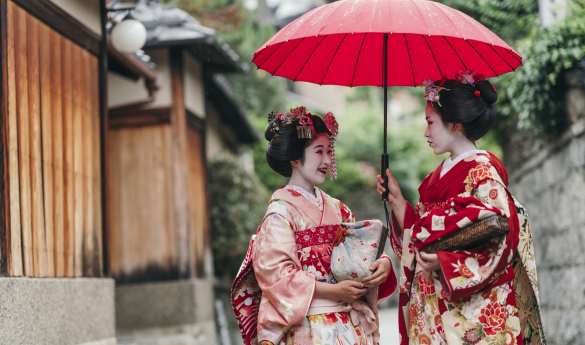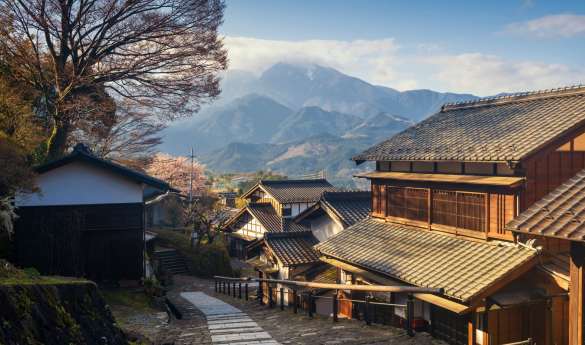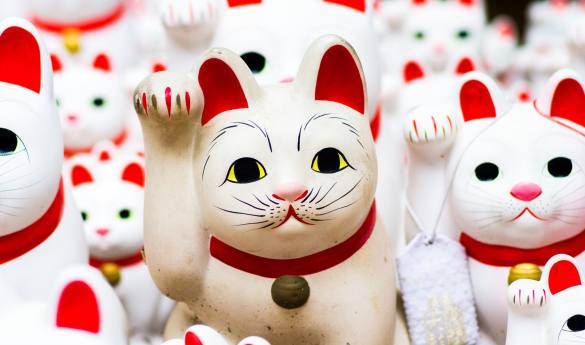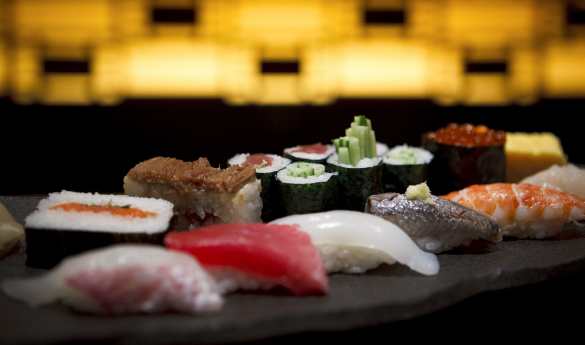5 Bucket List-Worthy Torii Gates to Visit in Japan
14 March 2023

Torii gates in Japan are beautiful structures found at the entrance of Shinto shrines to mark the passing from the human world into the spiritual one. Not only are they visually stunning, but they offer fascinating insight into Japan’s cultural traditions.
Found floating in lakes, lined up in a row of thousands, and hidden in dense forests, they are some of the most recognized and spectacular sites in Japan. If you are interested in Japanese culture, spirituality, history, or architecture, seeing a torii gate is a must for your itinerary.
What Are the Japanese Torii Gates?
Thought to be the home of Shinto gods, torii gates are mostly found at the entry to Shinto shrines and tend to be characterized by their bright red color. However, they were originally white to signify purity and there are even some plain wooden ones still found today.
When Buddhism arrived in Japan in the 6th century, shrines drew influence from the religion and started to paint their gates red to protect them against evil. This is now seen as representative of Shinto and Buddhist religions coming together. You can still see smaller versions of Japanese torii gates at the entrance to shrines in Buddhist temples too.
Because of the strong links between the Shinto religion and the Japanese imperial family, a torii also stands in front of the tomb of each deceased emperor. And some are placed amongst Japan’s outstanding nature, at the bottom of a mountain or coastline, for example. These torii gates are said to embody the gods that exist in nature, which is a Japanese animism belief.
What Do the Torii Gates Represent?
Japanese torii gates signify the invisible boundary between the human world and the holy Shinto one. Once you walk through the gate, you have entered a divine space. It is customary to bow before passing through, to walk slightly to the left or right of the center, and not to enter until you are in a state of purity. There will often be water nearby to rinse your hands and face first before passing through.
The Different Types of Torii Gates
Most torii gates look very similar, however, there are some subtle variations to look out for in their designs. These include:
- Posts (hashira) that are either vertical or at a slight angle
- Lintels (kasagi) across the top of the gate, which are either straight or curved
- Tie beams (nuki) held in place by wedges, which might protrude over the posts or not
- Some lintels are connected by a strut (gakuzuka), these are often covered by a wooden plaque with the name of the shrine inscribed on it
Torii gates in Japan are split into two main categories: Shinmei and Myōjin.
Shinmei
Thought to be the oldest type of torii, the Shinmei design is simple and characterized by straight lintels sitting across the top of two upright posts. One of the most well-known examples of a Shinmei torii gate is the modest but beautiful wooden one found at the entrance to the Inner and Outer Ise Shrines in Ise-Shima National Park. The Shinto shrines here are the most revered in Japan and seen as the country’s spiritual home.
Myōjin
The majority of torii gates in Japan are Myōjin. These can be recognized by their curved upper lintels, which point upwards, and slightly inclined posts. They will also have struts (gakuzuka) connecting the lintels. The bold, red, ‘floating’ torii gate at the entrance to Itsukushima Shrine on Miyajima is one of the most iconic examples of a Myōjin torii.
Different Torii Gate Colors
As covered above, most torii gates are red nowadays, however, you may see some that are wooden or white, and even some pink, blue, or yellow ones. A torii gates color is often in accordance to the direction the Shinto shrine faces. If the shrine is in the north, the torii gate will be black, in the east it is blue and in the center it is yellow. The pink torii gate is quite a rare example found in Higashimokoto Shibazakura Park, Hokkaido. It was painted for ornamental reasons, to complement the pink flowers that grow underneath it.
Best Torii Gates to Visit in Japan
Among the 90,000 torii gates in Japan, there are some real stand outs, which will become ingrained in your vacation memories. Here are our favorites, as chosen by our Japan travel experts.
Fushimi Inari-Taisha, Kyoto

Fushimi Inari-Taisha is one of the most legendary torii gates in Kyoto, Japan. Rather than being just one, it is a collection of 10,000, which flow like a red river down the hillside of Mount Inari. Located in southern Kyoto, these torii gates are devoted to the Shinto god of rice, Inari, and make up a striking 2.5-mile tunnel through the forest. Walking the trail is incredibly poignant and provides beautiful views over the city.
Best time to visit: To avoid the crowds, go very early in the morning, from 6:30 am, as it starts to get busy from 9 am. However, the early afternoon is a picturesque time to visit because of the light, especially in late spring and early summer (April to June).
Itsukushima Shrine, Miyajima

The UNESCO World Heritage Site Itsukushima Shrine sits on Miyajima Island and is dedicated to the gods of seas and storms. The shrine’s impressive torii gate was originally built in 593 CE and is located 650-ft from the coastline. When the tide is high, the gate appears to float, creating a stunning reflection in the water. The mixture of the deep blue ocean and the vermillion torii gate creates an astoundingly beautiful sight. Our favorite way to take it all in is via a kayak tour from the mainland to Miyajima Island.
Best time to visit: Try to time your visit with the high tide for the best photo opportunities, however, if you visit at low tide, you can reach the shrine on Miyajima Island by foot.
Meiji Shrine, Tokyo

This is one of Japan’s most famous and popular shrines, located just a stone’s throw from Harajuku Station. Offering a much-needed oasis for Tokyo’s city-dwellers, the entrance to Meiji Shrine is right next to Yoyogi Park. An enormous torii gate at the entrance signifies the passing from busy city life to the peaceful forest. Amongst the trees, you will find the main shrine buildings, which were built in 1920, and later reassembled following war damage. The Meiji Shrine is dedicated to the holy spirits of Emperor Meiji and his consort Empress Shoken. Here you will also find the Meiji Jingu Museum, which displays treasures belonging to the emperor and empress.
Best time to visit: Spring (March - May) and fall (September - November) are the best times to visit Meiji Shrine, this is when the large Inner Garden is in bloom, and you might spot a wedding ceremony or two. Avoid New Year’s Day when more than three million people go to pray for the first time in the year.
Kumano Hongu Taisha, Kumano Kodo

At the Kumano Hongu Taisha is one of the biggest torii gates in the world, which stands 109 feet tall and is the entrance to one of the three famous shrines on the Kumano Kodo pilgrimage trail. Hayatama and Nachi are the other two. It is dedicated to the sun goddess Amaterasu, as well as the deities of Kumano’s other major shrines. Owing to flooding in 1889, the shrine was moved from its location in Oyu no Hara to a new site half a mile away, but the torii gate is still in its original place.
Best time to visit: The scenery is spectacular and walking conditions are best in spring (March to June) and fall (September to November).
Hakone Shrine, Hakone

On the picturesque shores of Lake Ashi and at the base of Mount Hakone, there are three torii gates leading to Hakone Shrine. The largest and most iconic gate stands tall in the lake and is known as Heiwa no Torii, meaning Gate of Peace. This regal red torii gate has become a well-recognized image of Japan. Despite being located in the water, visitors can reach the gate by a 15-minute lakeside walk from Moto-Hakone Port and stand beneath the torii on a small landing that juts out from the lake’s edge. If you are visiting Japan with kids and want to combine culture with adventure, Hakone is the place to do it. Fuji-Hakone-Izu National Park has ropeways and cable cars to keep families entertained, as well as boat trips on Lake Ashi to take in the scenery, and some of Japan’s most revitalizing ryokans.
Best time to visit: There are fewer visitors in the summer (July and August) and winter (December to February) than in spring (March to May) or fall (September to November), when the weather is better. Whatever time of year you go, visit in the morning to avoid the crowds, although we love watching the sun go down over Lake Ashi too.
For guidance on which Japanese torii gates to visit and how to fit them into a luxury vacation in Japan, contact our travel experts via the contact form at the top of the page.
This entry was posted in and tagged Japan.
Start Planning Your Trip
Other blogs you may also be interested in...
Why Scott Dunn?
Unique to You

- We listen to your travel goals and craft unique trips that are personalized to you.
- We’re with you every step of your life’s travel journey, from honeymoons to family trips and beyond.
Seamless Service

- Global offices in the UK, US, Singapore, and Hong Kong for 24/7 seamless service.
- We offer flexibility if your plans change so you can book with confidence and peace of mind.
Carefully Curated Collection

- We’ve curated an elevated collection of accommodation, experiences, and guides.
- Committed to fostering close global relationships to continue bringing you unique experiences.
Luxury in Every Sense

- We deliver a sense of luxury that matters most to you.
- Awarded Condé Nast Traveler’s Top Travel Specialists in the World 12 years in a row.







